 |
PO
Box 9021, Wilmington, DE 19809, USA
E-mail: font@focusonnature.com
Phone: Toll-free in USA 1-888-721-3555
or 302/529-1876 |
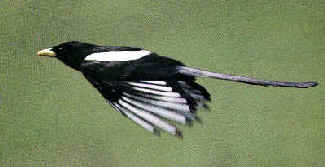 California
Birds
California
Birds
Noting those during
Focus
On Nature Tours
in central California
with an (*)
During the FONT West
Coast USA Tour
from 1991 thru 2015,
usually in the month of September
A central California bird list with some photos,
compiled by Armas Hill
UPPER RIGHT
PHOTO: The
YELLOW-BILLED
MAGPIE
is a bird endemic to California.
263 species of birds have cumulatively been seen
during 12 FONT West Coast birding and nature tours in California,
during the month of September.
Pelagic species during sea-trips from
Monterey, California
are indicated with an (mp).
Codes:
(USe): endemic to the United States
(USqe): quasi (or nearly) endemic to the USA
(USneb): near-endemic breeder in the USA
(NAi):
species introduced into North America
(CAi): species introduced into
California
(NAi): species introduced into North America
(CAi): species introduced in California
(CAe): endemic to California
(CAqe): quasi (or nearly) endemic to California
(NAr): rare in North America
(wNAr): rare in western North America
(CAr): rare in California
(t): a globally
threatened or rare species, designated by Birdlife International
(t1): critical (t2):
endangered (t3): vulnerable
(nt): a near-threatened
species globally
Bird whose names are capitalized in the list are uncommon or rare in
California.
(ph): species with a photo in the
FONT website
Species with a PR occur, or have occurred, in the area of
Point Reyes.
Noted with their status:
c: common fc: fairly common un: uncommon r: rare x:
extremely rare
Links:
Upcoming
Birding & Nature Tours in North America, including California
A Complete
List
(with some photos)
of North American Birds, north of Mexico, in 6 parts:
List
#1: Grouse to Anhinga List #2: Condor to Shorebirds
List #3: Jaegers to Cuckoos
List #4: Owls
to Flycatchers List #5: Shrikes to Pipits
List #6:
Olive Warbler to Buntings
Mammals
& some Other Wildlife during FONT tours in California
Marine Life
(inc. Fish, Jellyfish, Mollusks (Shells), & Arthropods: Crustaceans &
Echinoderms)
Directory
of Photos in this Website

Bird-List:
- Mountain Quail
(*)
______
Oreotyx p. pictus
(the
single member of is genus)
California Quail
(*)
______ PR:c
Callipepla californica brunnescens
Gambel's Quail
______
Callipepla gambelii
Chukar
Partridge
(NAi) ______
Alectoris
chukar
Common
(or
"Ring-necked")
Pheasant (NAi)
(*)
______ PR:u
Phasianus colchicus
Wild Turkey
(CAi) (ph) (*)
______
Meleagris gallopavo
Ruffed Grouse (ph) ______
Bonasa umbellus
Greater Sage Grouse (nt) (ph)
______
Centrocercus urophasianus
White-tailed Ptarmigan (CAi)
(ph)
______
Lagopus leucurus
Sooty Grouse ______
Dendragapus fuliginosus
The Sooty Grouse is part of the former "Blue
Grouse".
Sharp-tailed Grouse
______
Tympanuchus phasianellus
The Sharp-tailed Grouse is extirpated in California.
Black-bellied Whistling
Duck (ph) ______
Dendrocygna autumnalis
Fulvous Whistling Duck
______
Dendrocygna bicolor
Tundra Swan ______ PR:r
Cygnus c. columbianus
Trumpeter Swan (ph) ______
PR:x
Cygnus buccinator
Whooper Swan (NAr) (ph)
______
Cygnus cygnus
Brant (ph) (*)
______ PR:c
Branta bernicla nigricans
Canada Goose
(*)
______
PR:u
Branta canadensis
Cackling Goose (ph)
______
Branta
hutchinsii
Greater
White-fronted Goose
(*)
______ PR:r
Anser albifrons elgasi
Snow Goose (ph) ______
PR:r
Anser (has been
Chen)
caerulescens
Ross' Goose ______
PR:r
Chen
(has been Anser)
rossii
Emperor Goose (nt) ______
PR:x
Chen
(has been Anser)
canagica
Wood Duck (ph) ______
PR:r
Aix sponsa
In California, flocks
of hundreds of Wood Ducks are sometimes seen in the fall.
Mallard (ph)
(*)
______ PR:c
Anas p. platyrhynchos
Northern Pintail
(ph)
(*)
______ PR:c
Anas acuta
(monotypic)
Blue-winged Teal
(ph)
(*) ______
PR:r
Anas
discors (monotypic)
Cinnamon Teal
(*)
______ PR:c
Anas cyanoptera septentrionalium
Green-winged Teal
(ph)
(*) ______
PR:c
Anas carolinensis
Anas carolinensis
has been considered conspecific
with the
Eurasian Teal,
Anas crecca.
Northern Shoveler
(ph)
(*)
______
PR:c
Anas
clypeata (monotypic)
Gadwall
(ph)
(*)
______ PR:fc
Anas s. strepera
American Wigeon
(ph)
(*)
______
PR:c
Anas
americana
(monotypic)
Eurasian Wigeon (ph) ______
PR:r
Anas penelope
Falcated Duck (NAr) (ph)
______
Anas falcata
American Black Duck (CAr)
(ph) ______
Anas rubripes
Garganey (NAr)
______ PR:x
Anas querquedula
Baikal Teal (NAr)
(ph) ______
Anas formosa
Eurasian Teal
______ PR:x
Anas crecca
Redhead (ph)
(*)
______ PR:u
Aythya
americana
(monotypic)
Lesser Scaup
(ph)
(*)
______
PR:fc
Aythya
affinis
(monotypic)
Greater Scaup ______
PR:c
Aythya marita mariloides
Ring-necked Duck (ph) ______
PR:fc
Aythya collaris
Canvasback ______ PR:c
Aythya valisiineria
Common Pochard (NAr)
(ph) ______
Aythya ferina
Tufted Duck (NAr) (ph)
______ PR:x
Aythya fuligula
Steller's Eider (nt) (CAr)
(ph) ______
Polysticta stelleri
King Eider (ph) ______ PR:x
Somateria spectabilis
Harlequin Duck (ph)
(*)
______
PR:r
Histrionicus histrionicus
(now said to be monotypic) (the single member of its genus)
Surf Scoter
(ph)
(*)
______
PR:c
Melanitta
perspicillata
(monotypic)
White-winged Scoter
______ PR:c
Melanitta deglabdi
Black Scoter
(ph) ______ PR:u
Melanitta americana
Long-tailed Duck (nt) (ph) ______
PR:r
Clangula hyemalis
Common Goldeneye ______
PR:fc
Bucephala clangula
Barrow's Goldeneye (ph) ______
PR:r
Bucephala islandica
Bufflehead (ph)
(*)
______
PR:c
Bucephala
albeola (monotypic)
Smew (NAr) ______
Mergellus albellus
Common Merganser
(ph)
(*)
______ PR:r
Mergus merganser americanus
Red-breasted
Merganser
(ph)
(*)
______
PR:fc
Mergus
serrator
(monotypic)
Hooded Merganser (ph) ______
PR:r
Lodhodytes cucullatus
Ruddy Duck (ph)
(*)
______ PR:c
Oxyura j. rubida
Red-throated Loon
(ph)
(*)
______ PR:fc
Gavia stellata (monotypic)
Pacific Loon
(ph)
(*)
______ PR:fc
Gavia pacifica
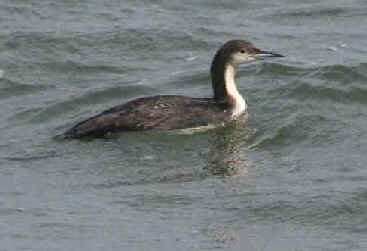
Pacific
Loon
Common Loon
(*) ______ PR:fc
Gavia immer (monotypic)
Yellow-billed Loon
______ PR:x
Gavia adamsii
Arctic Loon (CAr) ______
Gavia arctica
Black-footed
Albatross
(t3) (*) ______ (mp) PR:u
Phoebastria nigripes (monotypic)
The Black-footed Albatross is by far the most common of
the large tubenoses off the California seacoast, where it patrols the
coolest waters of the continental slope year-round, most commonly during the
summer months and most commonly north from Monterey Bay.
Laysan Albatross (t3) ______
PR:r
Phoebastria immutabilis
The Laysan Albatross is
rather rare in California oceanic waters. It tends to occur beyond the shelf
break in open ocean.
Short-tailed Albatross
(t3) (CAr)
______ PR:x
Phoebastria albatrus
Before 1900, the Short-tailed Albatross could be rather common
close to the California coast, but the decimation in the early 20th
Century of the nesting birds in Japan substantially reduced the
population.
Federally, the Short-tailed Albatross is classified as ENDANGERED.
Shy Albatross (NAr) (ph)
______
Thalassarche cauta
Light-manted Albatross (NAr)
______
Phoebetria palpebrata
Wandering Albatross (NAr)
______
Diomedea exulans
Northern Fulmar
(ph)
(*) ______ (mp)
PR:fc
Fulmarus glacialis rodgersii
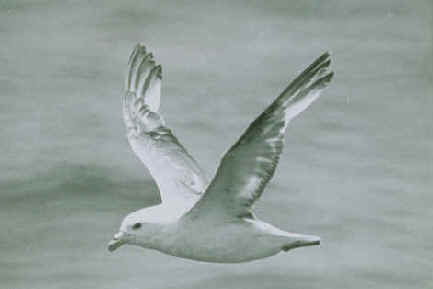
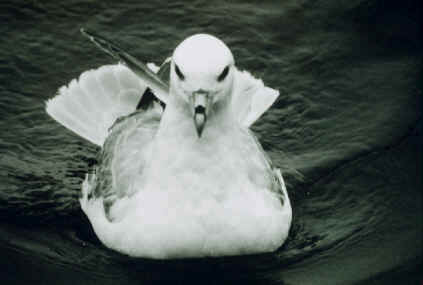
Northern Fulmar
(photos by Alan Brady)
White-chinned
Petrel (NAr) ______
Procellaria aequinoctialis
Great-winged
Petrel (NAr) ______
Pterodroma macroptera
HAWAIIAN PETREL
(t3) (NAr) (*) ______ (mp) (seen
during
the FONT tour in 2005)
Pterodroma sandwichensis (monotypic)
The Hawaiian Petrel was
conspecific with what is now the Galapagos Petrel. When so, it was
called the Dark-rumped Petrel.
Murphy's Petrel (nt)
______
Pterodroma ultima
Mottled Petrel (nt) (NAr) ______
PR:x
Pterodroma inexpectata
Cook's Petrel (t2) ______
Pterodroma cookii
Stejneger's Petrel (t3) (NAr)
______
Pterodroma longirostris
Bulwer's Petrel (NAr)
(ph) ______
Bulweria bulwerii
Streaked Shearwater (NAr)
______
Calonectris leucomelas
Cory's Shearwater (CAr)
(ph)
______
Calonectris diomedea
Sooty Shearwater (nt)
(ph)
(*)
______ (mp)
PR:c
Puffinus griseus (monotypic)
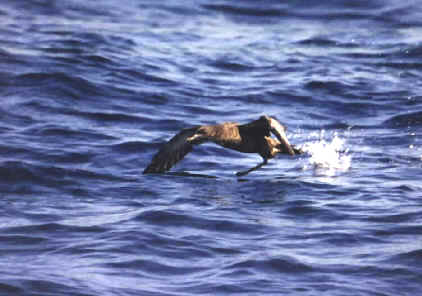
A
Sooty Shearwater photographed during a FONT tour.
Short-tailed
Shearwater
(ph)
(*) ______ (mp)
PR:r
Puffinus tenuirostris (monotypic)
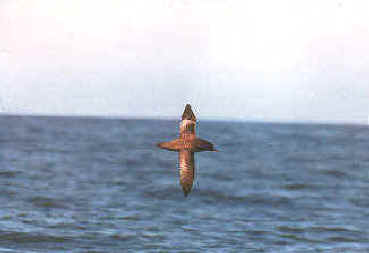
A
Short-tailed Shearwater photographed during a FONT tour.
Pink-footed
Shearwater (t3)
(ph) (*) ______ (mp) PR:u
Puffinus creatopus
(monotypic)
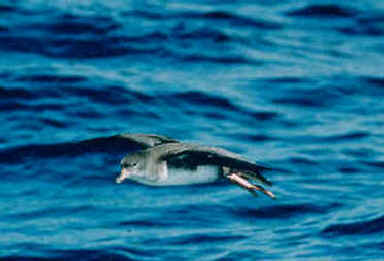
A
Pink-footed Shearwater photographed during a FONT tour.
Flesh-footed
Shearwater
(*) ______ (mp)
PR:r
Puffinus
carneipes (monotypic)
Buller's (or
New Zealand)
Shearwater
(t3) (*) ______ (mp)
PR;u
Puffinus bulleri (monotypic)
Black-vented
Shearwater
(t3) (*) ______ (mp)
PR:r
Puffinus
opisthomelas
(monotypic)
Great Shearwater (CAr)
______
Puffinus gravis
Wedge-tailed Shearwater (NAr)
______
Puffinus pacificus
Manx Shearwater (CAr)
______
Puffinus puffinus
Least Storm Petrel (*)
______ (mp)
Oceanodroma
(formerly
Halocyptena)
microsoma (monotypic)
Ashy Storm
Petrel
(nt) (CA:qe) (*) ______ (mp) PR:fc
Oceanodroma homochroa (monotypic)
The global population of the Ashy Storm Petrel is essentially
confined to offshore California islands: the Farallons (75 per cent of the
population) and the Channel Islands (the rest), where there are very limited
breeding opportunities in rocky crevices.
Most of these storm petrels flock together in Monterey Bay in the
fall, potentially exposing the entire population to any single, possible
calamity.
And of course the concentrated breeding colonies also face threats such as
nest disturbance by humans and livestock, and predation by introduced
mammals such as rats and cats, and depredation by gulls. These are threats
to many of California's seabirds, but the Ashy Storm Petrel, being so
local and geographically isolated, is especially susceptible.
Black Storm
Petrel (*)
______ (mp)
Oceanodroma
melania (monotypic)
Wilson's Storm
Petrel
(wNAr) (ph) (*) ______ (mp) PR:x
Oceanites o. oceanicus
Fork-tailed Storm Petrel
______ PR:r
Oceanodroma furcata
Leach's Storm Petrel
______ PR:u
Oceanodroma
leucorhoa
Various subspecies of Leach's
Storm Petrels have been seen in California offshore waters. Among the
notable subspecies in the eastern Pacific Ocean are these:
Oceanodroma leucorhoa chapmani (the "Chapman's Storm
Petrel"): Described in 1937. it differs from the nominate
subspecies (which is usually white-rumped) by having a smaller size and some
subtle differences in proportions, and by being mainly dark-rumped. It
occurs in the eastern Pacific ocean off California and Mexico.
Oceanodroma leucorhoa socorroensis (the "Townsend's
Storm Petrel"): Described in 1890. On islets off the south end of
the Guadalupe Islands of Mexico (mainly on Islote Afuera & on Isolote
Negro). It is a summer breeder. The population on Isolote Afuera has been
estimated as being about 4,000 birds, and that on Isolote Negro as 3,000
birds.
Oceanodroma leucorphoa cheimomnestes (the "Ainley's
Storm Petrel"): Described in 1980. On Guadalupe Island,
Mexico. It is a winter breeder. Generally, after breeding, the "Ainley's
Storm Petrel" seems to travel southward, based on limited specimen
data.
Wedge-rumped Storm Petrel
(NAr)
______
Oceanodroma tethys
Hornby's Storm Petrel (NAr)
______
Oceanodroma hornbyi
Pied-billed Grebe
(*)
______ PR:fc
Podilymbus p. podiceps
Least Grebe (ph) ______
Tachybaptus dominicus
Horned Grebe
(ph)
(*)
______ PR:fc
Podiceps auritus cornutus
Red-necked Grebe
(ph)
(*)
______
PR:u
Podiceps grisegena holboellii
Eared Grebe (ph) (*) ______
PR:fc
Podiceps nigricollis californicus
Another name for Podiceps
nigricollis is the Black-necked Grebe.
Western Grebe
(ph)
(*) ______
PR:c
Aechmophorus occidentalis
The Western Grebe and
the Clark's Grebe (below) were conspecific.
Clark's Grebe
(*) ______ PR:u
Aechmophorus clarkii
White-faced Ibis
(ph)
(*)
______ PR:x
Plegadis
chichi (monotypic)
Glossy Ibis (ph)
______
Plegadis falcinellus
American White Ibis
(ph) ______ PR:x
Eudocimus albus
Roseate Spoonbill
(ph) ______
Ajaia ajaja
Wood Stork (ph)
______ PR:x
Mycteria americana
American Bittern
(ph)
(*)
______ (seen
during
FONT California tours in 1991 & 2005)
PR:r
Botaurus lentiginosus
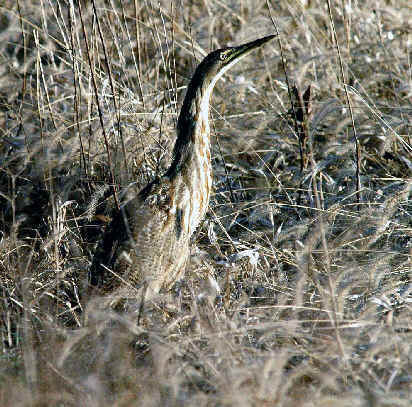
American
Bittern
(photo by Howard Eskin)
Least Bittern (ph)
______ PR:x
Ixobrychus exilis
Great Blue Heron
(*)
______
PR:c
Ardea herodias fannini
Great Egret
(ph)
(*)
______
PR:c
Casmerodius
(has
been Ardea) alba egretta
Snowy Egret
(ph)
(*)
______ PR:fc
Egretta thula brewsteri
Little Blue Heron
(ph)
______ PR:x
Egretta caerulea
Tricolored Heron
(ph) ______
Egretta tricolor
Reddish Egret (ph)
______
Egretta rufescens
Western Cattle Egret (ph)
______ PR:r
Bubulcus
ibis
Green Heron
(*)
______ PR:r
Butorides virescens anthonyi
Black-crowned Night
Heron (*) ______ PR:fc
Nycticorax nycticorax hoactli
Yellow-crowned Night
Heron (ph) ______
Nyctanassa violacea
RED-TAILED
TROPICBIRD (NAr) (*)
______ (mp) (seen
during
FONT tour in
1995)
Phaethon rubricauda melanorhynchos
Red-billed
Tropicbird (ph) ______
Phaethon aethereus
White-tailed Tropicbird
(ph) ______
Phaethon lepturus
Magnificent Frigatebird
(ph) ______ PR:x
Fregata magnificens
Great Frigatebird (NAr)
______
Fregata minor
Nazca Booby (ph)
______
Sula granti
Blue-footed Booby
(ph) _______
Sula nebouxii
Brown Booby (ph)
______
Sula leucogaster
Red-footed Booby
(ph) ______ PR:x
Sula sula
American White
Pelican
(ph)
(*)
______ PR:fc
Pelecanus erythrorhynchos
(monotypic)
Brown Pelican
(ph)
(*)
______
PR:c
Pelecanus occidentalis californicus
Both federally and in the state of
California, the Brown Pelican has been classified as ENDANGERED.
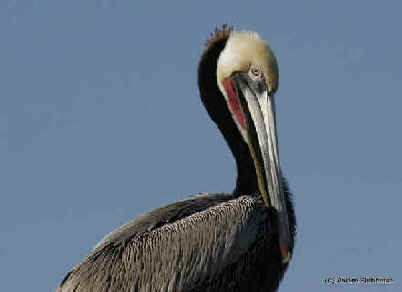
Brown Pelican, the race californicus
(photo by Abram Fleishman)
Double-crested
Cormorant
(*)
______ PR:c
Phalacrocorax auritus albociliatus
Brandt's Cormorant
(*)
______
PR:c
Phalacrocorax
penicillatus
(monotypic)
Pelagic Cormorant
(*)
______ PR:fc
Phalacrocorax pelagicus resplendens
Neotropic
Cormorant (ph) ______
Phalacrocorax brasilianus mexicanus
Anhinga (ph) ______
Anhinga anhinga leucogaster
Turkey Vulture
(ph)
(*)
______
PR:c
Cathartes a. aura
Black Vulture
(ph) ______
Coragyps atratus
California Condor (t1)
(ph) ______ (was extirpated in the wild in California; since
then, introduced)
Gymnogyps californianus
By 1982, only 22 free-ranging California Condors remained in
California. By 1986, only 1 female and 4 male condors roamed free.
The U.S. Fish & Wildlife sanctioned capturing those birds and adding
them to the captive breeding population. The last one was captured in April
1987.
In 1992, 63 condors existed in captivity. A few were released that
year into the wild. 8 young birds were returned to California, but within a
couple years, half had perished from collisions with power lines, shooting,
or poisoning.
Both federally
and in the state of California, the California Condor is classified
as ENDANGERED.
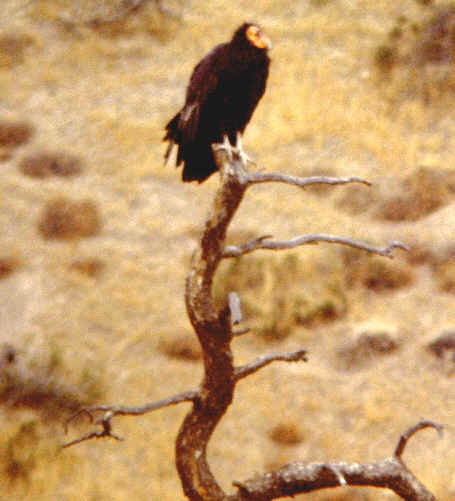
The above photograph, taken in California in 1981,
is one of the last California Condors in the wild.
(photo by Armas Hill)
Osprey
(ph)
(*)
______ PR:fc
Pandion haliaetus
carolinensis
(the single member of its genus)
White-tailed Kite
(ph)
(*)
______
PR:u
Elanus leucurus majusculus
Mississippi Kite
______
Ictinia mississippiensis
Bald Eagle
(ph)
(*)
______ PR:r
Haliaeetus leucocephalus
Federally the Bald
Eagle was classified as THREATENED. In California, it has been
classified as ENDANGERED.
Northern Harrier
(ph)
(*) ______
PR:fc
Circus hudsonius
The Northern Harrier has
been considered conspecific with the Hen Harrier, Circus
cyaneus, of Eurasia.
Sharp-shinned Hawk
(ph)
(*)
______ PR:fc
Accipiter striatus velox
Cooper's Hawk
(ph)
(*)
______
PR:fc
Accipiter cooperi
(monotypic)
Northern Goshawk _______
PR:x
Accipiter gentilis
Common Black Hawk
(ph) ______
Buteogallus anthracinus
Harris's Hawk (ph)
______
Parabuteo unicinctus harrisi
Red-shouldered Hawk (ph)
(*)
______
PR:fc
Buteo lineatus elegans
In the western
US, the Red-shouldered Hawk is almost entirely confined to California,
with a small number occurring into southern Oregon.
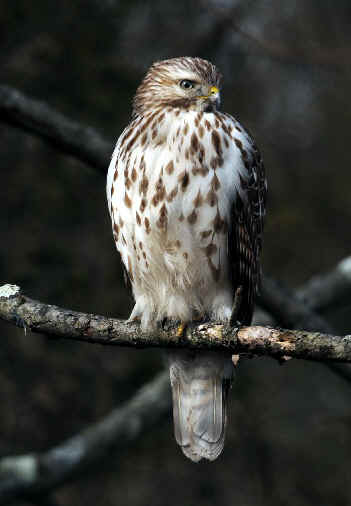
A
juvenile Red-shouldered Hawk
(photo by Howard Eskin)
Red-tailed Hawk
(ph)
(*) ______ PR:c
Buteo jamaicensis calurus (this subspecies of the western
US has pale, rufous, and dark morphs.)
Swainson's Hawk
(ph)
(*) ______ PR:x
Buteo swainsoni
(monotypic)
The Swainson's Hawk is
classified as THREATENED in California.
Buteo swainsoni occurs in two
morphs: light & dark.
Broad-winged Hawk
______ PR:r
Buteo p. platypterus
Ferruginous Hawk (nt)
(ph) ______ PR:r
Buteo regalis (monotypic)
Rough-legged Hawk (ph) ______
PR:r
Buteo lagopus sanctijohannis
Zone-tailed Hawk
(ph) ______
Buteo albonotatus
Golden Eagle
(*)
______ PR:r
Aquila chrysaetos canadensis
American Kestrel
(ph)
(*)
______ PR:c
Falco s. sparverius
Merlin
(ph)
(*)
______ PR:u
Falco c. columbarius
Peregrine Falcon
(ph)
(*)
______ PR:u
Falco peregrinus
Prairie Falcon
(ph)
(*)
______ PR:r
Falco mexicanus
Gryfalcon (ph) ______
Falco rusticolus
Ridgway's Rail
(ph)
(*)
______
(seen
during
the FONT California tour in 1994)
PR:x
Rallus obsoletus
(3
subspecies in California)
Rallus
obsoletus obsoletus (*)
Rallus obsoletus levipes
Rallus obsoletus yumanensis
Until 2014, the Ridgway's
Rail was part of the Clapper Rail.
Two of the
subspecies in California, obsoletus and yumanensis,
are classified in the state as ENDANGERED. Obsoletus is
classified as federally ENDANGERED.
Rallus obsoletus obsoletus, sometimes called the "California
Ridgway's Rail", is now restricted almost entirely to the San
Francisco Bay's tidal marshes. Formerly, Morro Bay was one of the few
locations outside the Bay Area where it occurred, but it has not been found
there since the mid 1970s.
Further southward, the below Point Conception, the "Light-footed
Ridgway's Rail", R. o. levipes, replaces obsoletus,
and although gone from most of its former haunts, it can still be found in
appropriate habitat in upper Newport Bay, the Tijuana River mouth, and
patches of habitat in the San Elijo Lagoon and south San Diego
Bay.
Virginia Rail
(ph)
(*) ______ (seen
during
the FONT California tour
in 1991) PR:fc
Rallus l. limicola
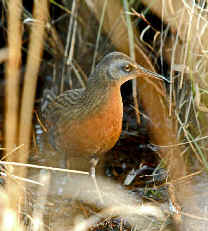
Virginia Rail
(photo by Howard Eskin)
Sora
(*) ______ PR:u
Porzana carolina
(monotypic)
Porzana
carolina is sometimes called Sora Rail, but actually
it is in a genus of crakes.
Black Rail ______ PR:r
Laterallus jamaicensis cortuniculus
The Black Rail is classified as THREATENED in California.
Yellow Rail ______ PR:x
Coturnicops noveboracensis
Common Gallinule
(ph)
(*) ______
PR:r
Gallinula
galeata
The Common Gallinule was
conspecific with the Common Moorhen of the Old World, Gallinula
chloropus.
Purple Gallinule
(ph) ______
Porphyrio martinica
American Coot
(*) ______
PR:c
Fulica a. americana
Sandhill Crane
(ph)
(*) ______ (seen
during
the FONT California tour
in 2005)
PR:x
Grus canadensis tabida
In California,
the Sandhill Crane, the subspecies g. c. tabida, is
classified as THREATENED.
Black-bellied Plover
(ph)
(*) ______
PR:c
Pluvialis squatarola cynosurae
American Golden
Plover (ph) ______ PR:u
Pluvialis dominica
Pacific Golden Plover
______ PR:u
Pluvialis fulva
Snowy Plover
(ph)
(*) ______
PRfc
Charadrius
nivosus
The Snowy Plover was conspecific with the Kentish
Plover, Charadrius alexandrinus,
of the Old World.
Federally, the Snowy Plover is classified as
THREATENED.
Semipalmated Plover
(ph)
(*)
______
PR:fc
Charadrius
semipalmatus
(monotypic)
LESSER SAND PLOVER (NAr)
(ph) (*) ______
(seen during the FONT California tour in
1992)
Charadrius mongolus stegmanni
Another name for Charadrius
mongolus has been the Mongolian Plover.
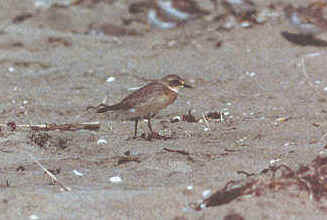
A
photograph of the Lesser Sand Plover seen during
the FONT tour in California in 1992.
Killdeer
(ph)
(*)
______
PR:c
Charadrius v. vociferus
Mountain Plover (nt) (USneb) (ph) ______
PR:x
Charadrius
montanus
The population of
the Mountain Plover has seriously declined in the last 25
years.
The species has been classified by Birdlife International as a "vulnerable"
species, but more recently its status has been downlisted to "near
threatened".
It has been said that about 80 per cent of the Mountain Plover population
winters in California, with nearly a quarter of them in the Central
Valley.
During a census in 1998, 2.663 birds were counted , with the two largest
flocks containing about 250 birds each. One of those flocks was in Yolo
County, and the other was in the Imperial Valley.
Wilson's Plover
(ph) ______
Charadrius wilsonia
Piping Plover ( )
(ph) ______
Charadrius melodus
Greater Sandplover (NAr)
______
Charadrius leschenaultii
Eurasian Dotterel (NAr) (CAr)
(ph) ______ PR:x
Charadrius morinellus
Black Oystercatcher (ph)
(*)
______ PR:u
Haematopus bachmani
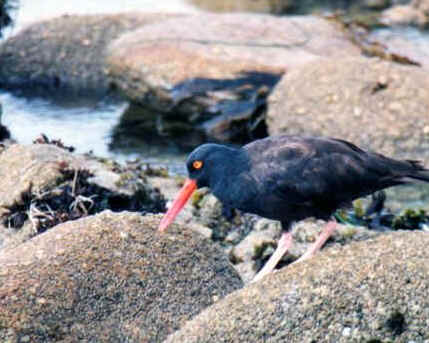
A
Black Oystercatcher photographed during a FONT West Coast Tour
(photo by Marie Gardner)
American
Oystercatcher (ph) ______
Haematopus palliatus
Black-necked Stilt
(ph)
(*)
______ PR:r
Himantopus mexicanus
The Black-necked
Stilt has been considered by some to be conspecific with the Black-winged
Stilt of the Old World.
American Avocet
(ph)
(*)
______
PR:fc
Recurvirostra
americana (monotypic)
Greater Yellowlegs
(*)
______ PR:fc
Tringa
melanoleuca (monotypic)
Lesser Yellowlegs
(ph)
(*)
______ PR:u
Tringa
flavipes
(monotypic)
"Western" Willet
(ph)
(*)
______ PR:c
Tringa
(formerly Catoptrophorus) semipalmata inornata
Solitary Sandpiper ______
PR:r
Tringa
solitarius
Common Greenshank (NAr)
______
Tringa nebularia
Spotted Redshank (NAr)
______
Tringa erythropus
Wandering Tattler
(*)
______
PR:u
Heteroscelus
incanus (monotypic)
Grey-tailed Tattler (NAr)
______
Heteroscelus brevipes
Spotted Sandpiper
(ph)
(*)
______ PR:u
Actitis
macularius (monotypic)
Terek Sandpiper (NAr)
______
Xenus cinereus
Upland Sandpiper (CAr)
______
Bartramia longicauda
"American" Whimbrel
(ph)
(*)
______ PR:u
Numenius phaeopus hudsonicus
LITTLE CURLEW (NAr)
(*) ______
(seen
during
the FONT California tour
in 1994)
Numenius minutus
Long-billed Curlew
(nt) (ph) (*) ______ PR:fc
Numenius americanus parvus
Bristle-thighed
Curlew (t3) (NAr) (CAr) ______
Numenius tahitiensis
Marbled Godwit
(ph)
(*)
______
PR:c
Limosa fedoa
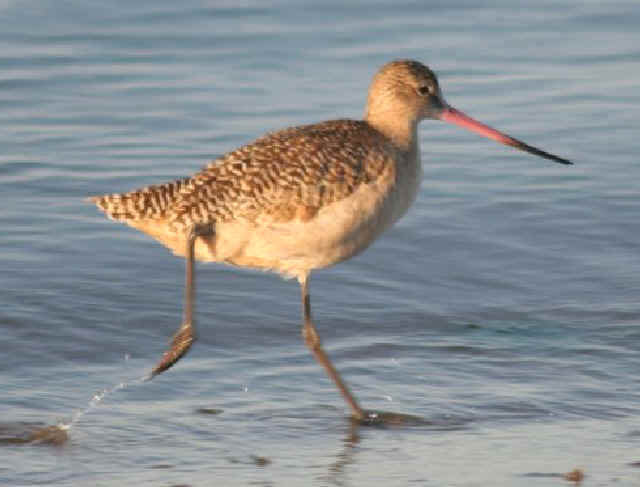
The Marbled Godwit
is a common bird
along the California coast in September
(photo by Abram
Fleishman)
BAR-TAILED GODWIT
(ph)
(*)
______ PR:x
Limosa lapponica baueri
Hudsonian Godwit
______
Limosa haemastica
Ruddy Turnstone
(ph)
(*)
______ PR:u
Arenaria interpres morinella
Black Turnstone
(*)
______ PR:c
Arenaria melanocephala
Surfbird
(*)
______ PR:r
Aphriza virgata (monotypic, and the single member of its genus)
In California, Surfbirds are very local, occurring rather
commonly at some sites, but very sparingly, if at all, at others.
It is always a surprise to see Surfbirds at Point Reyes, for example,
but they can be expected at Bodega Bay, in similar habitat, just 10 miles
north.
Red Knot
(ph)
(*) ______
PR:u
Calidris canutus rufa
Sanderling
(ph)
(*) ______
PR:c
Calidris alba rubida
Pectoral Sandpiper
(ph)
(*) ______
PR:u
Calidris
melanotos (monotypic)
Baird's Sandpiper
(ph)
(*) ______ PR:u
Calidris bairdii (monotypic)
Western Sandpiper
(ph)
(*)
______ PR:c
Calidris mauri
Semipalmated
Sandpiper (wNAr)
(*)
______ (during
the FONT California tour
in
1993) PR:r
Calidris pusilla
Least Sandpiper
(ph)
(*)
______ PR:c
Calidris minutilla
LONG-TOED STINT
(NAr) (ph) (*) ______ (during
the FONT California tour
in 1992)
Calidris subminuta
Dunlin
(ph)
(*)
______ PR:c
Calidris alpina
Rock Sandpiper
______ PR:x
Calidris ptilocnemis
The Rock
Sandpiper is essentially a sedentary resident of the Bering Sea shores,
but some of its population moves southward in the non-breeding season into
northern California. It is found, uncommonly, along Humboldt's craggier
coastline, and more rarely further south along the California
seacoast.
An apparent scarcity of the Rock Sandpiper in California in recent
decades may be the result of a northward contraction of its range in winter,
rather than a population decline.
White-rumped Sandpiper
______ PR:x
Calidris fuscicollis
Red-necked Stint (NAr)
(ph) ______
Calidris ruficollis
Little Stint (NAr)
______ PR:x
Calidris minuta
Sharp-tailed Sandpiper (NAr)
______ PR:x
Calidris acuminata
Curlew Sandpiper
(ph) ______ PR:x
Calidris ferruginea
Stilt Sandpiper ______
PR:x
Calidris
(has been Micropama) himantopus
Buff-breasted Sandpiper (nt)
(ph) ______ PR:x
Limicola falcinellus
Ruff / Reeve (ph)
______ PR:x
Philomachus pugnax
Short-billed
Dowitcher (ph)
(*)
______ PR:c
Limnodromus griseus
Long-billed
Dowitcher
(*)
______ PR:fc
Limnodromus scolopaceus
Wilson's
Snipe (ph) ______ PR:u
Gallinago delicata
Jack Snipe (NAr)
______
Lymnocryptes minmus
American Woodcock
(ph) ______
Scolopax minor
Wilson's Phalarope
(*)
______ PR:r
Phalaropus tricolor
Red Phalarope
(ph) (*) ______ (mp)
PR:fc
Phalaropus fulicaria
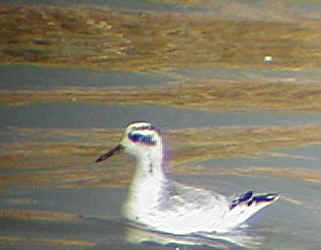
Red
Phalarope
Red-necked Phalarope
(ph) (*)
______ (mp)
PR:fc
Phalaropus lobatus
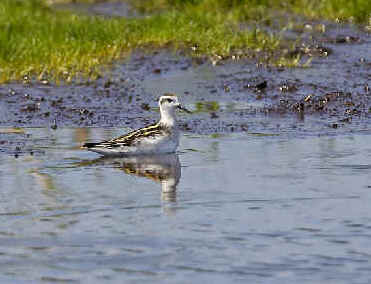
A
Red-necked Phalarope photographed during a FONT tour in California
Pomarine Jaeger
(ph) (*) ______ (mp)
PR:u
Stercorarius pomarinus (monotypic)
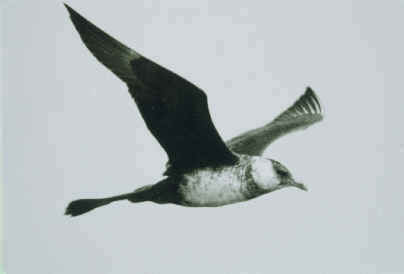
A
Pomarine Jaeger
(photo by Alan Brady)
Parasitic Jaeger
(ph) (*) ______
(mp)
PR:u
Stercorarius parasiticus (monotypic)
Long-tailed Jaeger
(ph)
(*)
______ (mp) PR:r
Stercorarius longicaudus
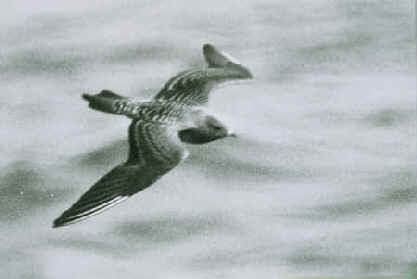
An
immature Long-tailed
Jaeger
(photo by Alan Brady)
South Polar Skua
(ph) (*) ______ (mp)
PR:r
Stercorarius
(or Catharacta) maccormicki
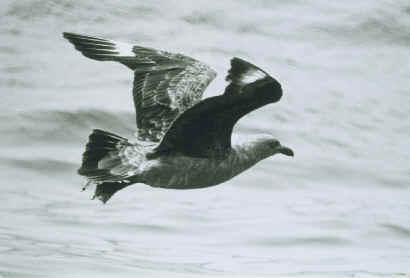
South
Polar Skua
(photo by Alan Brady)
Franklin's Gull
(ph) ______ PR:x
Leucophaeus
(formerly Larus) pipixcan
Laughing Gull (ph)
______
Leucophaeus
(formerly Larus) atricilla
Black-headed Gull
(ph) ______ PR:x
Chroicocephalus
(formerly Larus) ridibudus
Bonaparte's Gull (ph)
(*)
______ PR:fc
Chroicocephalus
(formerly Larus) philadelphia
Little Gull
(ph) ______ PR:x
Hydrocoloeus
(formerly Larus) minutus
Heermann's Gull
(nt) (ph) (*) ______ PR:c
Larus heermanni
The
Heermann's Gull breeds south of California on islands off Baja
California, Mexico. It is found along the California coast mainly in the
fall and winter, where it often accompanies Brown Pelicans, snapping up
fish that escape from the pelican's pouches.
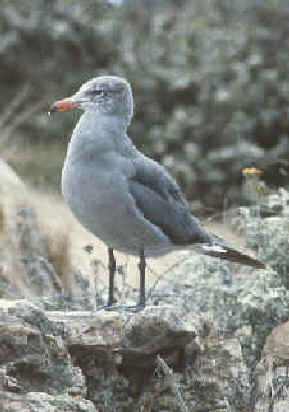
Heermann's Gull
(photo by Armas Hill)
Ring-billed Gull
(ph)
(*)
______ PR:c
Larus delawarensis
California Gull
(ph)
(*)
______
PR:c
Larus c. californicus
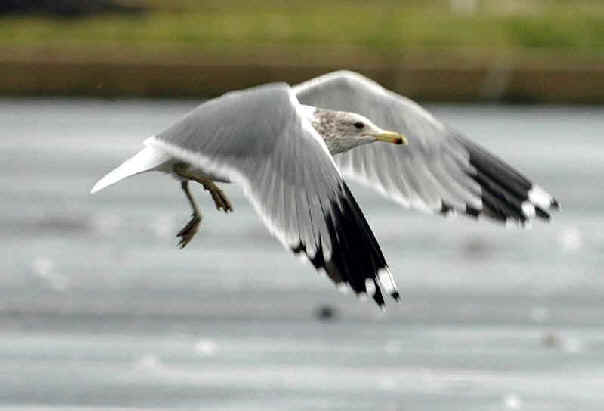
California Gull
(photo by Howard Eskin)
"American" Herring Gull
(*)
______ PR:fc
Larus argentatus smithsonianus
Western Gull
(*)
______ PR:c
Larus o. occidentalis
Glaucous-winged Gull
(*)
______ PR:c
Larus glaucescens
Mew Gull ______ (called
Common Gull
in Eurasia) PR:c
Larus canus brachyrhynchus
Yellow-footed Gull
(ph) ______
Larus livens
Thayer's Gull ______
PR:u
Larus thayeri
Glaucous Gull (ph)
______ PR:r
Larus hyperboreus
Iceland Gull (ph) ______
Larus glaucoides kumlieni
Lesser Black-backed Gull
(ph)
______
Larus fuscus graellsii
Belcher's Gull (NAr)
______ (has been called
Band-tailed Gull)
Larus belcheri
Black-tailed Gull (NAr)
(ph) ______
Larus crassirostris
Sabine's Gull (ph)
(*)
______ (mp)
PR:r
Xema sabini
Black-legged
Kittiwake (ph) (*) ______ (mp) PR:u
Rissa tridactyla
Red-legged Kittiwake ( )
(CAr) ______
Rissa revirostris
Ivory Gull (CAr)
(ph) ______
Pagophila eburnea
Gull-billed Tern ______
Gelochelidon
(formerly
Sterna)
nilotica
Caspian Tern (ph)
(*)
______ PR:c
Hydroprogne
(formerly
Sterna)
c. caspia
Arctic Tern
(*)
______ (mp) PR:u
Sterna paradisaea
Forster's Tern
(ph)
(*)
______ PR:c
Sterna forsteri
Common Tern
(*)
______ PR:u
Sterna h. hirundo
Royal Tern
(ph)
(*) ______ (seen
during
the FONT California tour
in 1992)
PR:x
Thalasseus
(formerly
Sterna)
m. maxima
Elegant Tern
(nt) (*) ______ PR:c
Thalasseus
(formerly
Sterna)
elegans
Sandwich Tern
______
Thalasseus (formerly
Sterna)
sandvicensis acuflavida
Least Tern ______ PR:x
Sternula (formerly
Sterna)
antillarum
Bridled Tern (ph)
______
Onychopion
(formerly
Sterna)
anaethetus
Sooty Tern (ph)
______
Onychopion
(formerly
Sterna)
fuscata
Black Tern (ph)
(*)
______ PR:x
Chlidonias niger surinamensis
WHITE-WINGED TERN
(NAr) (ph) (*) ______
(seen during the FONT California tour
in 1999)
Chlidonias leucopterus
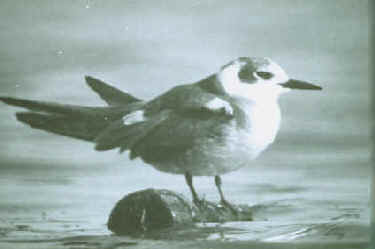
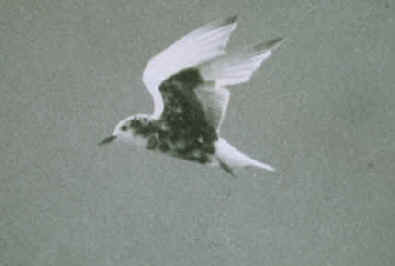
The
White-winged Tern is a Eurasian bird.
These two photos of the species were taken in North America.
(photos by Alan Brady)
Black Skimmer (ph)
______
Rynchops niger
Common Murre (ph)
(*)
______ (mp)
PR:c
Uria aalge californica
The Common Murre has been
a dominant member of the California breeding seabird community. It has had
a variable history of decline and recovery, but numbers have suffered in
recent decades because of mortality from the gill-net fishery and oil
spills. There has also been low reproductive success caused by an
increasing frequency of El Nino events.
In central California, the population was decimated in the late 1800s and
early 1900s by an "egging" operation out of San Francisco. After
the chicken poultry industry was established and the demand for Common
Murre eggs was reduced, the population rebounded and grew to several
hundred thousand breeding pairs in California by the early 1980s.
That recovery was marred, however, by intense mortality, as just noted, by
gill-netting, with as many as 70,000 murres known to have been
killed between 1979 and 1987. Legislation to abate "by killing"
was enacted in 1987, and the Common Murre was given a reprieve,
only to be later hit by oil spills in 1980 & 1984, among others, and
then some intense El Nino years
The central California population declined by 60 per cent in the 1980s,
and it has not substantially recovered since.
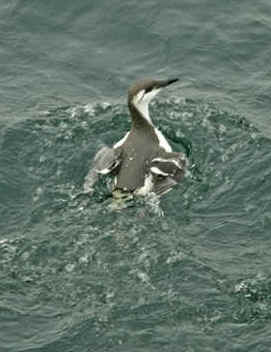
Common
Murre
(photo by Kim Steininger)
Thick-billed Murre
______
Uria lomvia
Pigeon Guillemot
(*) ______ (mp)
PR:fc
Cepphus c. columba
Marbled Murrelet (nt)
(*) ______ (mp)
PR:u
Brachyramphus marmoratus
The Marbled
Murrelet, a small seabird, has the curious and unusual trait of
nesting high in the limbs of old-growth coniferous trees in the
forest.
Its nesting habits are so unusual for a seabird that they remained a
mystery until 1974, when a nest was discovered in the Big Basin State
Park, in Santa Cruz County. Other than a smaller population in the
Santa Cruz Mountains, the entire breeding range of the Marbled Murrelet
in California is in the conifer forests on the immediate coast of Del
Norte, Humboldt, and northern Medocino Counties.
Federally, the Marbled Murrelet is classified as THREATENED. In
California, it is classified as ENDANGERED.
There is a fine book entitled "Rare Bird - Pursuing the Mystery of
the Marbled Murrelet", by Maria Mudd Ruth, published in 2005,
that is an excellent read about the bird.
Long-billed Murrelet
(NAr) (CAr) ______
Brachyramphus perdix
Kittlitz's Murrelet (t1)
(CAr)
______
Brachyramphus
brevorostris
Scripps's Murrelet
(t3) (*) ______ (mp) PR:r
(was part of what was the
Xantu's Murrelet, Synthliboramphus hypoleucus)
Synthliboramphus
scrippsi
Synthliboramphus scrippsi
occurs at sea mostly in California. Away from its breeding sites, it occurs north, rarely, to northern
California and more rarely to Oregon and Washington State, and south to southern Baja California, Mexico.
It breeds on islands off southern California: San Miguel, Santa Cruz,
Anacapa, Santa Barbara, San Clemente, and formerly Santa Catalina, and in
western Baja California, Mexico on San Benito, and Coronado and San
Jeronimo islands. On larger islands (such as San Miguel, Santa Cruz, and
San Clemente), it is confined largely or entirely to offshore
rocks.
Guadalupe Murrelet (t3)
______ (was part of what was the Xantu's Murrelet)
Synthliboramphus hypoleucus
Synthliboramphus hypoleucus
breeds on offshore rocks and islands off western Baja California, Mexico
from Guadalupe Island south to the San Benito Islands. Breeding is
unconfirmed on San Martin Island, in Baja California, and San Clemente and
Santa Barbara Islands in California, USA.
It presumably winters offshore within the breeding range along the Pacific
coast of Baja California.
Craveri's Murrelet
(t3) (*) ______ (mp)
Synthliboramphus craveri
Ancient Murrelet
______ PR:u
Synthliboramphus antiquus
Cassin's Auklet
(*)
______
(mp)
PR:c
Ptychoramphus aleuticus
The population of the Cassin's
Auklet has declined precipitously since the 1980s due to an increase
in ocean temperature and thermocline depth.
The decline of the species has also been due to predation by Western
Gulls at breeding sites, particularly at California's largest colony
of Cassin's Auklets, on the Farallon Islands.
The correlation between an increasing Western Gull population and a
decreasing Cassin's Auklet population is emblematic of unintended
consequences of the human urbanization of the California coast. Gulls on
the Farallon Islands commute regularly (even daily) from Bay Area
landfills and dumps, a distance of about 20 miles.
Cassin's Auklet numbers have also been declining at Price Island in
the Channel Islands.
Rhinoceros Auklet
(*)
______ (mp)
PR:u
Cerohinca monocerata
Parakeet Auklet ______
PR:x
Aethia psittacula
Least Auklet (ph)
______
Aethia pusilla
Crested Auklet ______
PR:x
Aethia cristatelia
Tufted Puffin ______
PR:r
Fratercula cirrhata
Horned Puffin ______
PR:x
Fratercula corniculata
Common (or
Feral) Pigeon
(NAi) (*)
______ PR:u
Columba livia
Band-tailed Pigeon
(*)
_______
PR:fc
Patagioenas
(formerly
Columba)
flavirostris
White-winged Dove
(*) ______
(seen during the FONT California tour in 1995) PR:x
Zenaida asiatica
Mourning Dove
(*)
______ PR:fc
Zenaida macroura
Inca Dove ______
Columbina (or Scardafella) inca
Common Ground Dove ______
Columbina passerina
Ruddy Ground Dove (NAr)
______
Columbina talpacoti
Spotted Dove (NAi)
______
Streptopelia chinensis
Eurasian Collared Dove (NAi)
______
Streptopelia decaocto
White-winged
Parakeet
(NAi) (*) ______ (seen during the FONT California tour in 1993)
Brotogeris versicolurus
What is now the White-winged
Parakeet was called the Canary-winged Parakeet. Native to South
America, the Canary-winged Parakeet has been "split" into
the Yellow-chevroned Parakeet, Brotogeris
chiriri, and the White-winged Parakeet.
Red-masked Parakeet/Conure
(nt) (NAi) (*) ______ (seen
during
the FONT California tour in 2005)
Aratinga erythrogenys
The native range of the Red-masked
Parakeet is in South America, mostly in Ecuador, also Peru.
It occurs in San Francisco, especially near Telegraph Hill.
Red-crowned Amazon (NAi)
______
Amazona viridigenalis
Yellow-billed
Cuckoo ______ PR:x
Coccyzus americanus
Black-billed Cuckoo
______ PR:x
Coccyzus erythropithimus
Greater Roadrunner (ph)
(*)
______
Geococcyx californianus
Groove-billed Ani
(CAr) ______
Crotophaga suicirostris
Barn Owl
(ph)
(*)
______ PR:fc
Tyto alba pratincola
Western Screech
Owl (ph) (*) ______ PR:u
Megascops
(formerly
Otus)
kennicottii
Flammulated Owl
______
Megascops
(formerly
Otus)
flammeolus
Great Horned Owl (ph)
(*)
______ PR:c
Bubo virginianus saturatus
Snowy Owl ______ PR:x
Bubo (formerly
Nyctea)
scandiacus
Northern Pygmy
Owl
(*)
______ PR:r
Glaucidium c. californicum (previously
Glaucidium gnoma,
which is now said to be
Mountain Pygmy-Owl
of Mexico & Central
America, reaching north into southern Arizona & New Mexico)
Elf Owl ______
Micrathene whitneyi
Burrowing Owl
(ph)
(*)
______ PR:r
Athene cunicularia hypugaea
Spotted Owl (ph) ______
PR:u
Strix occidentalis
The "Northern Spotted Owl", S. o. caurina,
is a characteristic bird of dense, fog-drenched forest. It is rarely
noticed because of its strictly nocturnal habits and its quiet demeanor.
Because of loss of habitat resulting from aggressive forestry practices in
older growth forests, the Spotted Owl is classified as a THREATENED SPECIES
both federally and in California.
It faces another threat as sell. Studies have shown that where the forest
has been fragmented by logging, the Barred Owl, Strix varia,
has encroached into territory formerly held by the Spotted Owl.
Although Spotted Owls require dense forest, Barred Owls are
more tolerant of open forests and thus are more adapted to the environment
being created by ongoing forestry practices.
Barred Owls were first detected in the northernmost Coast Ranges of
California in the early 1980s. By 2002, they had been found as far south
as the Muir Woods National Monument in Marin County, the southernmost
locale of the Northern Spotted Owl in the humid north coast forest.
The theory of "competitive exclusion"" suggest that two
such similar species can not coexist, and that ultimately one will
displace the other. Larger and adapted t more open habitat than the Spotted
Owl, the Barred Owl seems to have the competitive
advantage.
Barred Owl (ph) ______
Strix varia
Great Gray Owl (ph) ______
Strix nebulosa
The Great Gray Owl is classified as ENDANGERED in California.
Northern Long-eared Owl
(ph)
______ PR:r
Asio otus
Short-eared Owl (ph) ______
PR:r
Asio flammeus
Northern Saw-whet Owl
(ph)
______ PR:fc
Aegolius acadius
Common Nighthawk
(*)
______
PR:x
Chordeiles minor hesperis
Lesser Nighthawk ______
PR:x
Chordeiles acutipennis
Common Poorwill ______
PR:r
Phanaenoptilus nuttallii
Chuck-will's-widow (CAr)
______
Caprimulgus carolinensis
Buff-collared Nightjar (CAr)
______
Caprimulgus ridgwayi
Mexican Whip-poor-will
______ PR:x
Caprimulgus arizonae
American Black Swift
(*)
______ (during
the FONT California tour
in 1997) PR:r
Cypseloides niger borealis
Vaux's Swift
(*)
______ PR:u
Chaetura v. vauxi
Chimney Swift (CAr)
______ PR:x
Chaetura pelagica
White-throated Swift
(*)
______ PR:r
Aeronautes saxatalis
White-collared
Swift (CAr) ______
Streptoprocne zonaris
Broad-billed Hummingbird
______
Cynanthus latirostris
Xantu's Hummingbird (NAr)
(ph) ______
Hylocharis xantusii
Violet-crowned
Hummingbird (CAr) ______
Amazilia violiceps
Blue-throated Hummingbird
(CAr) ______ (also called
Blue-throated Mountaingem)
Lampornis clemenciae
Magnificent Hummingbird
______
Eugenes fulgens
Anna's Hummingbird
(ph)
(*)
______
PR:c
Calypte anna
Anna's Hummingbirds are
sexually dimorphic, as the plumage of each sex is distinct. The male is
festooned with a bright magenta-colored throat (or gorget) and head. The
female has a much less conspicuous plumage.
The Anna's is a common hummingbird, occurring across much of the
Pacific slope, moving easily (and often) among habitats, from chaparral and
coastal scrub through mixed woodland and riparian edges, exploiting a
variety of nectar sources during different seasons.
Males and females tend to have different habitat preferences, as sexually
dimorphic species often do. Male Anna's Hummingbirds take territorial
stands in more open situations, as up canyon sides or on hillslopes or out
of level washes, while females during the time of their nesting
activities adhere to tracts of evergreen trees, most commonly perhaps, those
of live oaks.
This separation of habitat use is possible because male Anna's
Hummingbirds are polygynous. They mate with many females and take no
part in nesting or chick rearing.
The widespread introduction of exotic fall-flowering trees and shrubs has
enabled Anna's Hummingbirds, both males and females, to overwinter in
California.
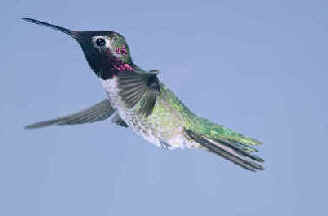
Anna's
Hummingbirds
Above:
a male
Below:
a female
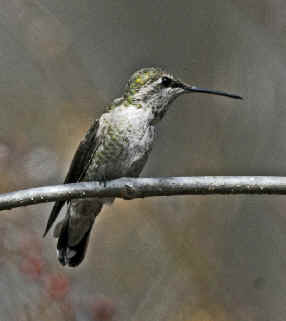
Black-chinned
Hummingbird (ph) ______ PR:x
Archilochus alexandri
Ruby-throated Hummingbird
(CAr) (ph) ______
Archilochus colubris
Costa's Hummingbird (ph)
______ PR:x
Calypte costae
Calliope Hummingbird (ph)
______ PR:r
Selasphorus
(formerly
Stellula)
calliope
Broad-tailed Hummingbird
(ph)
______
Selasphorus platycercus
Rufous Hummingbird (ph) ______
PR:u
Selasphorus rufus
Allen's Hummingbird (ph)
______ PR:c
Selasphorus sasin
The
breeding range of the Allen's Hummingbird conforms almost exactly
with that of the "Nuttall's" White-crowned Sparrow,
in the soft chaparral along the California coast.
Migrating Allen's Hummingbirds do well in suburban environments and
habitat edges within the coastal zone.
Belted Kingfisher (ph)
(*) ______ PR:fc
Megaceryle (formerly
Ceryle)
alcyon
Acorn Woodpecker (ph)
(*) ______ PR:c
Melanerpes formicivorus
The Acorn Woodpecker is
an oak-dependent species, rarely wandering far from a forest or savannah
with oak trees. Like jays, Acorn Woodpeckers harvest acorns
prodigiously but rather than burying them in the ground, they store their
bounty in trees. in "granaries", which they supply and maintain
communally.
The granaries, then, provide a food source for the woodpecker in winter and
spring, long after the trees have finished fruiting. Usually, each acorn is
placed in a small excavated hole. A variety of trees are selected from
granaries, but rarely do the birds use living oaks that have thin bark and
hard wood. They prefer the softer dead tissue found in thick-barked trees or
dead snags. They also use telephone poles and fence posts.
In older granaries, much of the tree or fence post may be riddled with
storage holes, but because the woodpeckers avoid living tissue, the borings
tend not to damage living trees. By avoiding the moist, living tree tissue
(cambium), the acorns dry more readily and are not subject to mold or rot.
The colony tends their cache, rotating acorns to aid drying and moving them
to smaller holes as the drying acorns shrink, Through their attentive
behavior, Acorn Woodpeckers are both stewards and parasites of the
oaks.
The stewardship, just described, has caused the Acorn Woodpecker
to evolve a complex, communal social system ("cooperative
breeding"). The woodpecker colony is an extended family (kinship) group
that consists of a breeding core of four or more related males, usually
brothers or a father and his sons, who share up to three related females,
usually sisters or a mother and her daughters. Older offspring may
participate in the group as "helpers", attending to the granaries
and assisting in raising younger birds.
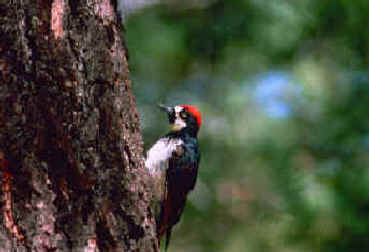
Acorn Woodpecker
(photo by Armas Hill)
Lewis's Woodpecker
______ PR:x
Melanerpes lewis
Small groups of Lewis's Woodpeckers sometimes nest in the
gaunt snags of burnt-out forests.
The Lewis's Woodpecker lacks the characteristic undulating flight of
other woodpeckers.
Red-headed Woodpecker (CAr)
(ph)
______
Melanerpes erthrocephalus
Gila Woodpecker (ph) ______
Melanerpes uropygialis
The Gila Woodpecker is classified as ENDANGERED in
California.
Williamson's Sapsucker
______
Sphyrapicus thyroideus
Red-naped Sapsucker (ph)
______ PR:x
Sphyrapicus nuchalis
Red-breasted Sapsucker
______ PR:u
Sphyrapicus ruber
Yellow-bellied Sapsucker
(CAr) ______ PR:x
Sphyrapicus varius
Nuttall's Woodpecker
(*) ______ PR:u
Picoides nuttallii
The Nuttall's Woodpecker is essentially a bird of
California's live oak woodlands, but it also breeds in Baja California and
wanders very rarely into Oregon and Nevada.
Ladder-backed Woodpecker
(ph) ______
Picoides scalaris
The Ladder-backed Woodpecker is very similar in
coloration to the Nuttall's Woodpecker, while its call, a series of
rapidly descending notes, is like that of the Downy Woodpecker.
White-headed Woodpecker
(*) ______ (during
FONT California tours in
1997 & 2004)
Picoides a. albolarvatus
Downy Woodpecker
(ph)
(*)
______ PR:fc
Picoides pubescens turati
Hairy Woodpecker
(ph)
(*)
______ PR:fc
Picoides villosus hyloscopus
(in
western
California) PR:c
Picoides villosus orius
(in
mountains of Washington & California)
PR:r
Black-backed
Woodpecker ______
Picoides arcticus
"Red-shafted" Northern
Flicker
(*)
______ PR:c
Colaptes auratus
Gilded Flicker (ph)
______
Colaptes chrysoides
The Gilded Flicker
is classified as ENDANGERED in California.
Pileated Woodpecker
(ph)
(*)
______ PR:r
Dryocopus pileatus
Olive-sided
Flycatcher
(*) ______ (an
alternate name could
be "Boreal
Pewee")
PR:fc
Contopus cooperi (was for a while
Contopus borealis)
Western Wood
Pewee
(*)
______ PR:c
Contopus sordidulus
Greater Pewee
______
Contopus pertinax
Pacific-slope
Flycatcher
(*)
______ PR:c
Empidonax difficilis
Willow Flycatcher
(*)
______
PR:r
Empidonax trailii
extimus
Both federally and in the state
of California, the Willow Flycatcher, the subspecies E. t.
extimus, are classified as ENDANGERED.
LEAST FLYCATCHER (wNAr)
(*)
______ (during
the FONT California tour
in 1991) PR:x
Empidonax minimus
Hammond's
Flycatcher ______ PR:x
Empidonax hammondii
Gray Flycatcher ______
PR:x
Empidonax wrightii
Dusky Flycatcher
(ph) ______ PR:x
Empidonax obehholseri
Cordilleran Flycatcher
______
Empidonax occidentalis
Yellow-bellied Flycatcher
______
Empidonax flaviventris
Alder Flycatcher ______
Empidonax alnorum
Black Phoebe
(*) ______
PR:c
Sayornis nigricans
Say's Phoebe
(ph)
(*)
______ PR:u
Sayornis saya
Eastern Phoebe
______ PR:x
Sayornis phoebe
Vermilion
Flycatcher (ph) ______
Pyrocephalus rubinus
Ash-throated Flycatcher
(ph)
(*)
______ PR:fc
Myiarchus cinerascens
Brown-crested
Flycatcher ______
Myiarchus tyrannulus
Dusky-capped Flycatcher
(ph)
______ PR:x
Myiarchus tuberculifer
Nutting's Flycatcher
______
Myiarchus nuttingi
Great Crested Flycatcher
(ph) ______ PR:x
Myiarchus crinitus
Brown-crested Flycatcher
______
Myiarchus tyrannulus
Sulphur-bellied
Flycatcher (CAr) ______
Myiodynastes luteiventris
Western Kingbird (ph)
(*)
______ PR:u
Tyrannus verticalis
EASTERN KINGBIRD (wNAr)
(ph) (*) ______
(during FONT
California tours
in 1991 & 2005)
PR:x
Tyrannus tyrannus
Cassin's Kingbird
______ PR:x
Tyrannus vociferans
Tropical Kingbird
(ph) ______ PR:r
Tyrannus melancholicus
Couch's Kingbird (CAr)
(ph) ______
Tyrannus couchii
Thick-billed Kingbird (CAr)
______
Tyrannus crassirostris
Scissor-tailed Flycatcher
(CAr) (ph) ______ PR:x
Tyrannus forficalus
Fork-tailed Flycatcher (NAr)
(ph) ______
Tyrannus savana
Loggerhead Shrike (ph)
(*)
______
PR:u
Lanius
l. ludovicianus
Lanius ludovicianus mearnsi
The subspecies L. l. mearnsi is federally classified as an ENDANGERED
subspecies. Called the San Clemente Loggerhead Shrike, it is
restricted to San Clemente Island, 49 miles from the mainland, and 56 square
miles in size. Thus, this subspecies has seemingly the smallest range of any
bird in North America, and it is one of the most endangered. Although the shrikes
formerly occurred throughout the island, defoliation and predation by feral
cats and ravens have taken their toll.
Northern Shrike
(ph) ______ (called the Great Grey Shrike in
Eurasia) PR:x
Lanius excubitor
Brown Shrike (NAr)
_______ PR:x
Lanius cristatus
Cassin's Vireo (*) ______ (was called Solitary Vireo when it was conspecific
with what are now the Plumbeous and Blue-headed
Vireos) PR:r
Vireo cassinii
Plumbeous Vireo
______ (was called
Solitary Vireo, as was the Cassin's Vireo) PR:x
Vireo
plumbeus
Hutton's Vireo
(*)
______ PR:fc
Vireo huttoni
Warbling Vireo
(*)
______ PR:c
Vireo gilvus
White-eyed Vireo
(ph) ______ PR:x
Vireo griseus
Bell's Vireo (nt) ______
PR:x
Vireo bellii
Two subspecies of the Bell's Vireo are classified in California
as ENDANGERED: V. b. arizonae
& V. b. pusillus.
Vireo b. pusillus is federally
classified as ENDANGERED.
Gray Vireo ______
Vireo vicinior
Yellow-throated Vireo
______ PR:x
Vireo flavifrons
Blue-headed Vireo (ph) ______
PR:x
Vireo solitarius
Philadelphia Vireo ______
PR:x
Vireo philadelphicus
Red-eyed Vireo ______
PR:x
Vireo olivaceus
Yellow-green Vireo ______
Vireo flavoviridis
Gray Jay
(ph) ______
Perisoreus canadensis
Steller's Jay (ph) (*)
______ PR:c
Cyanocitta stelleri carbonacea
Blue Jay
(ph) ______
Cyanocitta cristata
Western
Scrub Jay (ph) (*) ______ PR:c
Aphelocoma c. californica
Island Scrub Jay (CAe)
______
Aphelocoma insularis
The Island
Scrub Jay is restricted entirely to Santa Cruz Island (with 96 square
miles) off the southern California coast. It differs from its closest
relative on the mainland, the Western Scrub Jay, by its larger size,
brighter blue color, hoarser voice, and different breeding
behavior.
Pinyon Jay
(*) ______ (during
the FONT California tour
in 2004) PR:x
Gymnorhinus cyanocephalus
Clark's Nutcracker
(*)
______ PR:x
Nucifraga columbiana
Black-billed Magpie
(*) ______
(was conspecific
with the Eurasian Magpie,
Pica
pica)
Pica hudsonia
Yellow-billed Magpie
(CAe) (USe) (ph) (*) ______
Pica nuttalli
In California only, the Yellow-billed Magpie ranges
throughout the Central Valley, and along the south coast, but nowhere else
except as a rare vagrant.
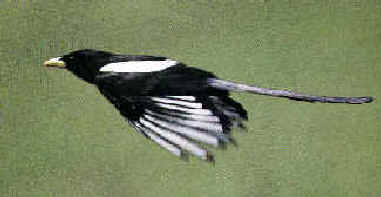
Yellow-billed
Magpie
American Crow
(*)
______ PR:fc
Corvus brachyrhnchos hesperis
Northern
Raven (ph)
(*)
______ PR:fc
Corvus corax principalis
Horned Lark
(ph)
(*)
______ PR:fc
Eremophila alpestris
Eurasian Skylark (NAr)
______ PR:x
Alaudia arvensis
Cedar Waxwing (ph) ______
PR:fc
Bombycilla garrulus
Bohemian Waxwing ______
Bombycilla garrulus
Phainopepla (ph) (*)
______ PR:x
Phainopepla nitens
Purple Martin (ph) ______
PR:r
Progne subis
Tree Swallow (ph)
(*) ______ PR:c
Tachycineta bicolor
Violet-green Swallow
(*)
______ PR:c
Tachycineta t. thalassina
Bank
Swallow ______ (also called Sand
Martin) PR:r
Riparia r.
riparia
The Bank Swallow is
classified as THREATENED in California.
Barn Swallow (ph)
(*) ______ PR:c
Hirundo rustica erythrogaster
American Cliff Swallow
______ PR:c
Petrochelidon
pyrrhonota
Northern
Rough-winged Swallow
(ph) (*)
______ PR:fc
Stelgidopteryx s. serripennis
Chestnut-backed
Chickadee
(*)
______ PR:c
Poecile r. rufescens
(two other subspecies along California
coast: P.r. neglectus & P.r. barlowi)
Mountain Chickadee
(*)
______
PR:x
Poecile gambeli baileyae
Black-capped Chickadee
(ph)
______
Poecile
atricapilla
In California, the Black-capped
Chickadee is a montane breeder with a distribution extending into the
state to the Klamath Mountains and coastward only as far south as Humboldt
County.
Oak Titmouse (*) ______ (was
at one time part of Plain Titmouse when it was conspecific with
what
is now the Juniper Titmouse)
PR:u
Baeolophus i. inornatus
Juniper Titmouse
______ (was part of the
Plain Titmouse, as was the
Oak Titmouse)
Baeolophus ridgwayi
Verdin (ph) ______
Auriparus flaviceps
American Bushtit (ph)
(*) ______ PR:c
Psaltriparus minimus
(a complex species with 11 subspecies in 3
"groups")
In California, these 2 subspecies, in the "Minimus
Group", the "Plain Bushtit":
P. m. minimus (along coastal California)
P. m. californicus
(in California east of the Coastal Range)
Birds in the "Plumbeous Group", the "Lead-colored Bushtit",
P. m. plumbeous, also occur in California east of the Sierra Nevada.
Red-breasted
Nuthatch
(ph)
(*)
______ PR:u
Sitta canadensis
White-breasted
Nuthatch
(ph)
(*)
______ PR:r
Sitta carolinensis aculeata
Pygmy Nuthatch
(ph)
(*)
______ PR:c
Sitta pygmaea melanotus
(in
northern California)
Sitta p.
pygmaea (in
coastal, central California)
Brown Creeper
(ph) (*) ______
(an alternate name could be
"American
Treecreeper") PR:fc
Certhia americana occidentalis
Cactus Wren (ph) ______
Campylorhynchus brunneicapillus
Rock Wren (ph) (*)
______ PR:u
Salpinctes o. obsoletus
Canyon Wren ______ PR:x
Catherpes mexicanus
Bewick's Wren
(*)
______ PR:c
Thryomanes bewickii spilurus
(in central California)
House
Wren (ph)
(*)
______
PR:r
Troglodytes aedon
Pacific Wren (*)
______
(was part of the Winter Wren) PR:c
Troglodytes
pacificus
Marsh Wren
(ph)
(*) ______
PR:c
Cistothorus palustris
aestuarinus
(subspecies in coastal & central California)
Sedge Wren (ph) ______
PR:x
Cistothorus platensis
American Dipper ______
PR:x
Cinclus mexicanus
Ruby-crowned Kinglet (ph)
(*) ______ PR:c
Regulus calendula
Golden-crowned Kinglet
(ph)
______ PR:fc
Regulus satrapa
Blue-gray Gnatcatcher
(ph) (*) ______ PR:r
Polioptila caerulea
California
Gnatcatcher ______
Polioptila californica
The California and Black-tailed Gnatcatchers are
two sibling species that were, until recently, considered subspecies of
the same species.
The California Gnatcatcher is a bird of the coastal scrub. The Black-tailed
Gnatcatcher is thoroughly desert adapted.
The subspecies of the California Gnatcatcher, P.
c. californica, is federally classified as
THREATENED.
Black-tailed Gnatcatcher
______
Polioptila melanura
Lanceolated Warbler (NAr)
______
Locustella lanceolata
Dusky Warbler (NAr)
______
Phylloscopus fuscatus
Arctic Warbler (CAr)
______
Phylloscopus borealis
Red-flanked Bluetail
(ph) ______
Luscinia (formerly
Tarsiger)
cyanurus
Northern Wheatear
(ph) ______
Oenanthe oenanthe
Western Bluebird
(ph)
(*)
______ PR:fc
Sialia mexicana
Mountain Bluebird
(ph)
(*)
______ PR:x
Sialia currucoides
Townsend's Solitaire
______ PR:x
Myadestes townsendi
Swainson's Thrush
(*)
______
PR:c
Catharus
u. ustulatus
The nominate subspecies of the Swainson's
Thrush is a summer visitor to California coastal woodlands which
resonate, when the birds are there, with their ascending flute-like songs,
that are among the most beautiful to be heard in the state, or anywhere.
The subspecies Catharus u. ustulatus was described by Nuttall in
1840. 3 other subspecies of the Swainson's Thrush also occur
in California.
Hermit Thrush (ph) ______
PR:c
Catharus guttatus
Veery ______ PR:x
Catharus fuscescens
Gray-cheeked Thrush
______ PR:x
Catharus minimus
Wood Thrush ______ PR:x
Hylocichia mustelina
American Robin (*)
______
PR:c
Turdus migratorius
Rufous-backed Robin (NAr)
______
Turdus rufopalliatus
Eye-browed Thrush (NAr)
______
Turdus obscurus
Varied Thrush (ph) ______
PR:fc
Ixoreus naevius
The Varied Thrush is a
denizen of the shady forest, of redwood and spruce, where its sound can be
heard, a strange, mechanical "veeeer".
California Thrasher
(CAqe) (*)
______
Toxostoma redivivum
Bendire's Thrasher
______
Toxostoma bendirei
Le Conte's Thrasher
______
Toxostoma lecontei
Crissal Thrasher ______
Toxostoma crissale
Curve-billed Thrasher
______
Toxostoma curvirostre
Brown Thrasher ______
PR:x
Toxostoma rufum
Sage Thrasher (ph)
______ PR:x
Oreoscoptes montanus
Northern Mockingbird
(ph)
(*)
______
PR:u
Mimus polyglottos
Gray Catbird
(ph) ______ PR:x
Dumetella carolinensis
Common Starling
(NAi) (ph) (*)
______ PR:c
Sturnus vulgaris
Wrentit (*)
______ PR:fc
Charmaea fasciata
The distinctive call of the Wrentit is often the only clue
to the presence of that secretive denizen of tangled scrub. It is a
year-round resident in chaparral and coastal scrub, and endemic to the
West Coast from southern Oregon to far-northern Baja California.
House Sparrow (NAi)
(*)
______
PR:c
Passer domesticus
American Pipit ______
PR:fc
Anthus rubescens
Olive-backed Pipit (NAr)
(ph) ______
Anthus hodgsoni
Red-throated Pipit (CAr)
______ PR:x
Anthus cervinus
Sprague's Pipit ( ) (CAr)
______
Anthus spragueii
Eastern Yellow Wagtail (CAr)
______ PR:x
Motacilla tschutschensis
Grey Wagtail (CAr)
______
Motacilla cinerea
White Wagtail (CAr)
(ph) ______ (includes what has been the Black-backed
Wagtail)
Motacilla alba
Brambling (NAr)
______
Fringilla montifringilla
Gray-crowned Rosy Finch
(ph)
______
Leucosticte tephrocotis
Black Rosy Finch
(ph) ______
Leucosticte atrata
Pine Grosbeak (ph) ______
Pinicolas enucleator
Purple Finch (ph) (*)
______ PR:c
Haemorhous
(formerly
Carpodacus)
purpureus
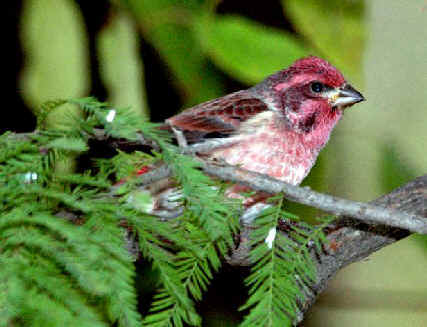
A
male Purple Finch
(photo by Howard Eskin)
Cassin's Finch
(ph)
(*) ______
PR:x
Haemorhous
(formerly
Carpodacus)
cassinii
House Finch
(ph)
(*) ______
PR:c
Haemorhous
(formerly
Carpodacus) mexicanus
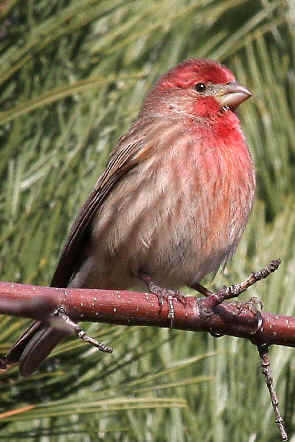
House Finch
(photo by Doris Potter)
Red Crossbill
(ph)
(*) ______
PR:u
Loxia curvirostra
White-winged
Crossbill (ph) ______
Loxia leucoptera
Common Redpoll (ph)
______
Acanthis
(formerly Carduelis) flammea
Pine Siskin (ph)
(*) ______
PR:c
Spinus (formerly
Carduelis)
pinus
Lesser Goldfinch
(*) ______
PR:fc
Spinus (formerly
Carduelis)
psaltria
Lawrence's Goldfinch
(*) ______
(during
FONT California tours twice) PR:x
Spinus
(formerly
Carduelis)
lawrencei
American Goldfinch
(ph)
(*)
______
PR:c
Spinus
(formerly
Carduelis)
tristis
Evening Grosbeak
(ph)
_____ PR:r
Coccothraustes vespertinus
BLACK-AND-WHITE
WARBLER (wNAr)
(*) ______ (during the FONT California tour in 1998)
PR:r
Mniotilta varia (monotypic, and the single member of its genus)
Blue-winged
Warbler (ph) ______
Vermivora
pinus
Golden-winged Warbler
______
Vermivora chrysoptera
Orange-crowned
Warbler
(ph)
(*)
______ PR:c
Oreothlypis
(formerly
Vermivora)
celata
Nashville Warbler (ph) ______
PR:r
Oreothlypis
(formerly
Vermivora)
ruficapilla
Tennessee Warbler
(ph) ______ PR:r
Oreothlypis
(formerly
Vermivora)
peregrina
Virginia's Warbler ______
PR:x
Oreothlypis (formerly Vermivora) virginiae
Lucy's Warbler ______
PR:x
Oreothlypis
(formerly
Vermivora)
luciae
Yellow Warbler (ph)
(*) ______ PR:fc
Setophaga
(formerly
Dendroica) petechia
"Audubon's" Yellow-rumped Warbler
(*)
______ PR:c
Setophaga
(formerly
Dendroica) coronata auduboni
"Myrtle"
Yellow-rumped Warbler ______ PR:c
Setophaga (formerly
Dendroica)
c. coronata
NORTHERN PARULA
(wNAr) (ph) (*) ______ PR:r
Setophaga
(formerly
Parula)
americana
Black-throated Gray
Warbler
(*)
______ PR:u
Setophaga
(formerly
Dendroica)
nigrescens
BLACK-THROATED BLUE
WARBLER (wNAr)
(*) ______ (during
the FONT California tour in 1991) PR:r
Setophaga
(formerly Dendroica) caerulescens
Townsend's Warbler
(*)
______ PR:fc
Setophaga
(formerly
Dendroica)
townsendi
Hermit Warbler
(*) ______
PR:u
Setophaga
(formerly
Dendroica)
occidentalis
Palm Warbler
______ PR:r
Setophaga (formerly
Dendroica)
palmarum
BLACKPOLL WARBLER (ph) (*) ______
(during the FONT California
tour in 1991) PR:r
Setophaga
(formerly Dendroica) striata
Chestnut-sided Warbler
(ph) ______ PR:r
Setophaga
(formerly
Dendroica)
pensylvanica
Magnolia Warbler
(ph) ______ PR:r
Setophaga
(formerly
Dendroica)
magnolia
Cape May Warbler ______
PR:r
Setophaga
(formerly
Dendroica)
tigrina
Black-throated Green
Warbler (ph) ______ PR:r
Setophaga
(formerly
Dendroica)
virens
Golden-cheeked Warbler (t2
) (CAr) ______
Setophaga
(formerly
Dendroica)
chrysoparia
Blackburnian Warbler
(ph) ______
Setophaga
(formerly
Dendroica)
fusca
Yellow-throated Warbler
(ph) ______ PR:x
Setophaga
(formerly
Dendroica)
dominica
Grace's Warbler ______
Setophaga
(formerly
Dendroica)
graciae
Pine Warbler _______
PR:x
Setophaga
(formerly
Dendroica)
pinus
Prairie Warbler
(ph) _______ PR:r
Setophaga
(formerly
Dendroica)
discolor
Bay-breasted Warbler
______ PR:r
Setophaga
(formerly
Dendroica)
castanea
Cerulean Warbler (t3) (CAr)
______ PRx
Setophaga
(formerly
Dendroica)
cerulea
Prothonotary Warbler
______ PR:x
Protonotaria citrea
Worm-eating Warbler
______ PR:x
Helmitheros vermivorum
Ovenbird (ph)
______ PR:r
Seiurus aurocapilla
Northern Waterthrush
______ PR:r
Parkesia noveboracensis
Louisiana Waterthrush
______
Parkesia motacilla
Connecticut Warbler
______ PR:x
Oporornis agilis
(now the single member of its genus)
Mourning Warbler
(ph) ______ PR:x
Geothlypis
(formerly
Oporornis)
philadelphia
MacGillivray's
Warbler
(ph)
(*)
______ PR:u
Geothlypis
(formerly
Oporornis)
tolmiei
Common Yellowthroat
(ph)
(*)
______ PR:fc
Geothlypis trichas
Kentucky Warbler
______ PR:x
Geothlypis
(formerly
Oporornis)
formosa
Hooded Warbler ______
PR:x
Setophaga
(formerly
Wilsonia)
citrina
Wilson's Warbler
(*)
______ PR:c
Cardellina
(formerly
Wilsonia)
pusilla
Canada Warbler
______ PR:x
Cardellina (formerly
Wilsonia)
canadensis
Red-faced Warbler (CAr)
______
Cardellina
rubrifrons
AMERICAN REDSTART (wNAr)
(ph) (*)
______ (during
the FONT California tour in 1991) PR:r
Setophaga ruticilla
Painted Whitestart
(ph) ______ PR:x
Myioborus pictus
Yellow-breasted
Chat (ph) ______ PR:r
Icteria virens
Red-winged Blackbird (ph)
(*)
______ PR:c
Agelaius phoeniceus
Tricolored Blackbird
(*)
______
PR:c
Agelaius tricolor
The Tricolored Blackbird
is a gregarious species, often nesting in large colonies in California lowlands and
foothills. It is nearly endemic to California, rarely spilling over the
borders of the state, with small colonies in southern Oregon and Baja
California.
In recent years, the species
has had a declining population.
Tricolored Blackbirds are ""itinerant breeders",
moving among areas to nest sequentially within a single season. Grasslands
in central California regularly support colonies from 5,000 to 10,000
breeding birds and even larger wintering
flocks.
Yellow-headed
Blackbird
(ph)
(*)
______
(during
the FONT California
tour 1998) PR:x
Xanthocephalus xanthocephalus (monotypic, and the single member of
its genus)
Western Meadowlark
(*)
______ PR:fc
Sturnella neglecta
Brewer's Blackbird
(ph)
(*)
______ PR:c
Euphagus cyanocephalus
Rusty Blackbird
(ph) ______ PR:x
Euphagus
carolinus
Brown-headed Cowbird
(ph)
(*)
______ PR:fc
Molothrus ater
Great-tailed
Grackle (ph) ______
Quiscalus mexicanus
Common Grackle ______
PR:x
Quiscalus quiscula
Hooded Oriole
(*)
______
(during
the FONT
California tour
in 1991) PR:x
Icterus cucullatus
Bullock's Oriole
(ph)
(*) ______ (for a while was merged
with the Baltimore Oriole,
and called Northern Oriole)
PR:u
Icterus bullockii
Scott's Oriole (ph)
______ PR:x
Icterus parisorum
Orchard Oriole (ph)
______ PR:x
Icterus spurius
Baltimore Oriole
(ph) ______ PR:x
Icterus galbula
Streak-backed Oriole
______
Icterus pustulatus
Bobolink (ph)
______ PR:r
Dolichonyx oryzivorus
Green-tailed Towhee (ph)
______ PR:x
Pipilo chlorurus
(formerly
Chlorura
chlorurus)
Spotted Towhee (ph)
(*)
______ PR:c
Pipilo maculatus
The Spotted Towhee
was called Rufous-sided Towhee when it was conspecific with what is
now the Eastern Towhee of North America and the Olive-sided and
Socorro Towhees of Mexico.
The Spotted Towhee is now said to be conspecific with the Collared
Towhee of Mexico.
California Towhee
(*) ______ PR:c
Melozone
crissalis
(formerly Pipilo crissalis)
The California Towhee was
called Brown Towhee was it was conspecific with the now Canyon
Towhee, Pipilo fuscus.
The subspecies of the California
Towhee, P. c. eremophilus, is classified federally and in California as
ENDANGERED. That subspecies is known as the Inyo California Towhee.
Fewer than 200 individuals are known to exist. It is a relict population of
a species that was historically widespread in the southwestern United States
and northern Mexico.
Due to prehistoric climatic changes beginning in the Pliocene, this
population became restricted to mountain areas in the northern Mojave
Desert. Its range is now limited to riparian habitats within the southern
Argus Range in Inyo County, where it is geographically isolated from other
subspecies of the California Towhee. The population is dependent on a
limited riparian habitat that has been reduced or eliminated by human
activities, such as grazing, removal of water, mining, recreational and
military activities, and
"development"..
Abert's Towhee (ph)
______
Melozone aberti
(formerly Pipilo aberti)
Rufous-crowned Sparrow (ph)
(*)
______ PR:r
Aimophila r. ruficeps
Cassin's
Sparrow ______
Peucaea cassinii (formerly
Aimophila cassinii)
Chipping Sparrow
(ph)
(*)
______ PR:u
Spizella passerina boreophila
Brewer's Sparrow
(nt) (ph)
(*)
______ PR:x
Spizella b. breweri
(this subspecies valid as long as
"Timberline Sparrow" of Canada is considered conspecific)
Clay-colored
Sparrow (ph) ______ PR:r
Spizella pallida
Black-chinned Sparrow
______ PR:x
Spizella atrogularis
American Tree Sparrow
(ph)
______ PR:x
Spizelloides arborea (formerly
Spizella arborea)
Field Sparrow _______
Spizella pusilla
Vesper Sparrow
(*) ______ (an uncommon migrant in
California) PR:r
Pooecetes gramineus affinis
Lark Sparrow
(ph)
(*)
______ PR:r
Chondestes grammacus
Black-throated
Sparrow (ph) ______ PR:x
Amphispiza bilineata
Sagebrush Sparrow (ph)
(*)
______
Artemisiospiza
(formerly Amphispiza) nevadensis
The Sagebrush
Sparrow was called the Sage Sparrow.
Bell's
Sparrow ______ PRx
Artemisiospiza belli
The Bell's Sparrow is the former Sage Sparrow of coastal
California.
The subspecies of the Sage
Sparrow, A. belli clementae, is federally classified as
THREATENED.
Lark Bunting (ph)
______ PR:x
Calamospiz melanocorys
Savannah Sparrow
(ph)
(*)
______ PR:c
Passerculus sandwichensis
(the single member of its genus)
Passerculus sandwichensis rostratus
Passerculus sandwichensis beldingi
The endangered "Belding's Savannah Sparrow", P.
s. beldingi, still continues as a permanent resident of fragmented
marshes from Santa Barbara southward to San Diego.
Another race so distinctive, that some have considered it a species, is the "Large-billed
Savannah Sparrow". P. s. rostratus, with a wintering range
in California restricted entirely to tidal marshes from San Diego north to
Morro Bay.
The subspecies P. s. beldingi is classified as ENDANGERED in
California.
Grasshopper Sparrow (ph)
______ PR:u
Ammodramus savannarum
Baird's Sparrow ______
Ammodramus bairdii
LeConte's Sparrow
(ph) ______
Ammodramus leconteii
Nelson's Sparrow ______
(was formerly, with the
Saltmarsh Sparrow, part of the
Sharp-tailed Sparrow) PR:x
Ammodramus nelsoni
"Slate-colored" Fox Sparrow ______
PR:c
Passerella iliaca schistacea
Song Sparrow (ph)
(*)
______ PR:c
Melospiza melodia (there are 11 subspecies in California)
Three distinct geographic
races of endemic salt marsh Song Sparrows are restricted almost
entirely to the San Francisco tidal marshes:
M. m. samuelis, the "San Pablo Song Sparrow",
M. m. maxillaris, the "Suisun Song Sparrow", and
M. m. pusillula, the "Alameda Song Sparrow".
Among the most sedentary of California's birds, these tidal marsh Song
Sparrows maintain territories year-round, although they actively defend
them only in the breeding season, which, as with most resident birds, begins
yearly in the season. However, these marsh-dwelling sparrows nest
even earlier than the sparrows in adjacent upland habitats. They are in full
song by mid-February, and eggs incubated by mid-March. Because the marsh
sparrows build their nests mostly in tidal marsh vegetation, often
within a few inches of the ground, early nesting enables the sparrows to
fledge young before spring high tides inundate the marshes each May and
June.
Other marsh-nesters also phase their nesting to miss the high springs
tides.
Although their habitat is quite restricted in extent, the marsh sparrows
occur in extremely high densities, an average of about 9 birds per acre. The
needs a sparrow pair and offspring (they may produce 2 or 3 clutches in a
season) are provided year-round within a fraction of an acre, indicative of
the richness of tidal marsh habitat.
The songs of Song Sparrows vary widely among individuals and
populations, but collectively these variations are characteristic of
California's wetlands.
Lincoln's Sparrow
______ PR:u
Melospiza lincolnii
Swamp Sparrow (ph) ______
PR:r
Melospiza georgiana
White-crowned
Sparrow (ph) (*)
______
PR:c
Zonotrichia leucophrys nuttalli
The "Nuttall's
White-crowned Sparrow", Z. l. nuttalli, is a year-round
resident along the immediate California coast. In the spring, its sweet song
is heard from the lupine-covered dunes and coastal scrub within the
"fog belt",
Other more-northerly subspecies, the "Gambel's" and the "Puget
Sound" White-crowned Sparrows. Z. l, gambelii and Z.
l. pugetensis respectively, arrive in California to
spend the winter, but the "Nuttall's" stays all
year.
Along the California coast, from Bodega Bay to Bolinas, there is a distinct
variation in the basic song of the resident White-crowned Sparrows.
Usually the last four notes of the song vary, but in a recognizable way. The
dialects do not change gradually, but rather abruptly, so the Boderga
dialect sounds nothing like that of Bolinas. These sparrow s are sedentary,
and therefore evolutionary products of their coastal neighborhoods. Through
their songs, the birds may express a subtle variety that exists in their
natural habitat, the soft chaparral of California's central
coast.
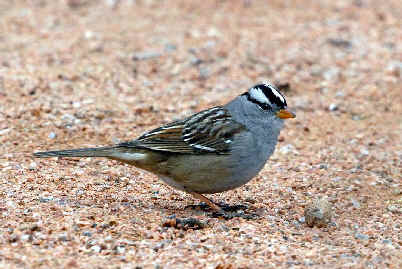
White-crowned
Sparrow
(photo by
Howard Eskin)
Golden-crowned
Sparrow ______ PR:c
Zonotrichia atricapilla
White-throated Sparrow
______ PR:r
Zonotrichia albicollis
Harris's Sparrow
(ph) ______ PR:x
Zonotrichia querula
"Oregon"
Dark-eyed Junco (*) ______
Junco hyemalis oreganus
PRc
Junco
hyemalis shufeldti
(coastal California)
PRr
Junco hyemalis pinosus
(in hills in central California)
Junco hyemalis
caniceps
PRx
Lapland Longspur (ph)
______ PR:r
Calcarius lapponicus
Chestnut-collared
Longspur (ph) ______ PR:r
Calcarius ornatus
McCown's Longspur
(ph) ______ PR:x
Calcarius mccownii
Smith's Longspur (ph) _______
Calcarius pictus
Little Bunting (NAr)
______
Emberiza pusilia
Rustic Bunting (NAr)
______
Emberiza rustica
Snow Bunting (ph)
______ PR:x
Calcarius
(formerly
Okectrophenax)
nivalis
Western Tanager (ph) (*)
______ PR:u
Piranga ludoviciana
Summer Tanager (ph)
______ PR:x
Piranga rubra
Hepatic Tanager ______
Piranga hepatica
Scarlet Tanager (ph) _______
PR:x
Piranga olivacea
Dickcissel (ph)
______ PR:x
Spiza americana
Northern Cardinal
(ph) ______
Cardinalis cardinalis
Pyrrhuloxia (ph) ______
Cardinalis sinnatus
Black-headed
Grosbeak (*)
______ PR:fc
Pheucticus melanocephalus
ROSE-BREASTED
GROSBEAK (wNAr)
(ph) (*) ______
(during
FONT California tours in 1998 & 2005)
PR:r
Pheucticus ludovicianus
Blue Grosbeak (ph)
______ PR:x
Passerina caerulea
Lazuli Bunting (ph) ______
PR:u
Passerina amoena
Indigo Bunting (ph)
______ PR:r
Passerina cyanea
Varied Bunting ______
Passerina versicolor
Painted Bunting
(ph) ______
Passerina ciris

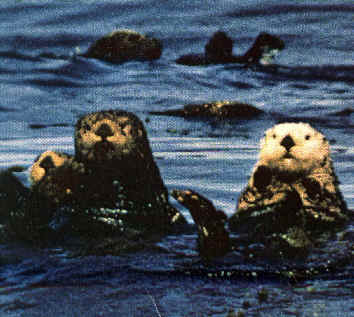 MAMMALS
MAMMALS
(land and marine)
during
Focus On Nature Tours
in central
California
1991 thru
20
15
during the month of September
List compiled by Armas Hill
Seen offshore during
Monterey CA pelagic trips: (mp)
- Virginia Opossum
(ph) ______
Didelphis virginiana
California Myotis ______
Myotis californicus
Big Brown Bat ______
Eptesicus fuscus
Northern River Otter ______
Lontra canadensis
Sea Otter
(ph) ______ (seen during all tours)
(IN PHOTO AT TOP OF LIST)
Enhydra lutris
Coyote
(ph) ______
Canis latrans
Gray Fox ______
Urocyon cinereoargenteus
Bobcat
(ph) ______
Lynx rufus
California Sea Lion
(ph) ______
(the
Galapagos Sea Lion
is a race of this species, there is
another rare subspecies in Japan)
Zalophus californiannus
Northern Fur Seal
(ph) ______ (mp)
Callorbinnus ursinus
Harbor Seal
(ph) ______
Phoca vitulina
Northern Elephant Seal ______
Mirounga angustirostris
California Ground Squirrel ______
Spermophilus beecheyi
Merriam's Chipmunk ______
Tamias merriami
Panamint Chipmunk ______
Tamias panamintinus
Western Gray Squirrel ______
Sciurus griseus
Desert Cottontail
(ph) ______
Sylvilagus audubonii
Brush Rabbit ______
Sylvilagus bachmani
Black-tailed Jackrabbit
(ph) ______
Lepus californicus
Tule Elk ______
Cervus elaphus nannodes (a subspecies of the Elk
native to California)
Mule Deer
(ph) ______
Odocoileus hemionus
(Common) Fallow Deer
(NAi)
(ph) ______ (feral
population in California; native to the Mediterranean region of the Old
World)
Dama dama
(Short-beaked) Common Dolphin
(ph) ______ (mp)
Delphinus delphis
Northern Right Whale Dolphin ______ (mp)
Lissodelphis borealis
Pacific White-sided Dolphin ______ (mp)
Lagenorhynchus obliquidens
Risso's Dolphin
(ph) ______ (mp) (also
called
Gray Grampus)
Grampus griseus
Orca
(ph) ______ (mp)
(also called
Killer Whale)
Orcinus orca
Short-finned Pilot Whale ______ (mp)
Globicephala macrorhynchus
Baird's Beaked Whale
(ph) ______
(mp)
(8
seen nicely during 2005 tour)
Berardius bairdii
Gray Whale ______ (mp)
Eschrichtius robustus
Humpback Whale
(ph)
______ (mp)
Megaptera novaeanliae
Blue Whale
(ph) ______ (mp)
Balaenoptera musculus
Reference for this mammal list is the new book:
"Mammals of North America" by Roland W. Kays & Don E. Wilson,
published by Princeton Univ Press, 2002.

Other
Wildlife:
Leatherback Sea Turtle
(ph)
______ (mp)
Dermochelys coriacea
Blue Shark ______ (mp)
Prionace glauca
Thresher Shark ______ (mp)
Alopias
vulpinus
Ocean Sunfish (ph)
______ (mp)
Mola mola
To
Top of Page



 California
Birds
California
Birds 






























![]()
 MAMMALS
MAMMALS
![]()